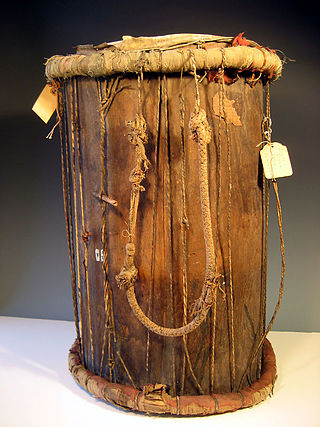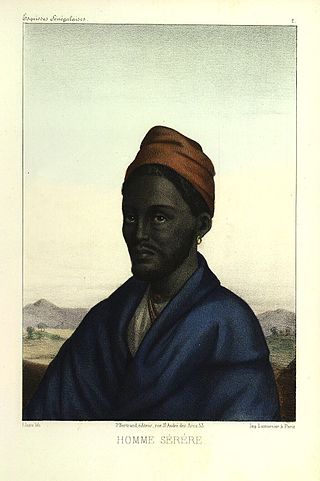Maad Saloum Fode N'Gouye Joof (in Gambian English; or Fode Juuf in Serer [1] ) was the last king of Saloum. He reigned as Maad Saloum from 1935 to 1969. His royal title Maad Saloum means King of Saloum in Serer. [2] [3] [4] [5] [6]
His residence was at Guinguinéo. [7] Like many of the Serer kings during their medieval dynastic history, Fode was a member of the noble Joof patriclan and the Guelwar matriclan—the two dynastic families who have reigned in Sine and Saloum for centuries. Both his parents were of Guelowar matrilineage. He was a member of the Keway Begay clan. [8] Keway Begay was one of three sisters whose maternal descendants reigned in Saloum for several centuries. Fode was the son of King of Saloum—Ndeneh Jogop Joof (Fr. Ndéné Diogop Diouf) and Lingeer Ngouye Ndour, the Queen of Saloum, later Queen Mother. On his paternal side, he was of the noble Joof family who have reigned in precolonial Senegambia since lamanic times. His father was from Diagnel where Fode was born. On his maternal side, he was from Selik which is the village of the male descendants of the founder of the Guelowar dynasty in Saloum—Maad Saloum Mbegan Ndour (reigned: 1493 [9] ). Fode was a veteran of World War I, an Officer of the Legion of Honor, and commander of the national order of merit. He was Chief of the cantons of Kolobane, Laghem, Ndoukoumane, Pakala and Mandakh, and eventually Chief of the province of Kahone. He was advisor to independent Senegal. His death in 1969—almost simultaneous with that of Maad a Sinig Mahecor Joof—the last Maad a Sinig (King of Sine), ended the reign of the great and noble Joof and Guelowar dynasties. [5] [10]

The Kingdom of Saloum was a Serer kingdom in present-day Senegal as well as Gambia, then called Lower Saluum. The precolonial capital of Saloum was the city of Kahone. It was a sister to the Kingdom of Sine. Their history, geography and culture were intricately linked and it was common to refer to them as the Sine-Saloum and the Serer Kingdoms of Sine and Saloum.

The Serer people are a West African ethnoreligious group. They are the third-largest ethnic group in Senegal, making up 15% of the Senegalese population. They also reside in northern Gambia and southern Mauritania.

The Kingdom of Sine was a post-classical Serer kingdom along the north bank of the Saloum River delta in modern Senegal.
Maad a Signig Kumba Ndoffene Famak Joof was the King of Sine in modern-day Senegal. Maad a Sinig means king of Sine. He ruled from 1853 until his death on 23 August 1871. He was the son of Maad Souka Ndela Joof and Lingeer Gnilane Jogoy Joof. His father – Maad Souka Ndela came from The Royal House of Semou Njekeh Joof founded by Maad Semou Njekeh Joof in the early 18th century, which was the third and last Royal House of Joof family of Sine and Saloum. His paternal family ruled three Kingdoms : Sine, Kingdom of Saloum and previously the Kingdom of Baol. They descended from Maad Ndaah Njemeh Joof the 13th century King of Lâ (Laah) in Baol.

The Battle of Fandane-Thiouthioune, also known as the Battle of Somb or the Battle of Somb-Tioutioune, occurred on 18 July 1867. It was a religious war between the Serer people and the Muslim Marabouts in 19th-century Senegal and the Gambia, but it also had a political and economic dimension to it: vendetta and empire-building. Fandane, Thiouthioune and Somb were part of the pre-colonial Serer Kingdom of Sine, now part of independent Senegal.
Guelowar, also spelled Gelwar, Guelwar, Guelware, Gueleware or Gueloware, was a maternal dynasty in the pre-colonial Serer kingdoms of Sine and Saloum. They were from the Mandinka ethnic group. The offspring of Mandinka women and Serer men became the kings of Sine and Saloum. The dynasty lasted from the mid-14th century to 1969, the year both kings died.
Maad a Sinig Mahecor Joof was the last king to rule the Serer Kingdom of Sine, now part of independent Senegal. Maad a Sinig means king of Sine in the Serer language. He reigned from 1924 until his death in 1969. After his death, the Kingdom of Sine was incorporated into independent Senegal.

Joof or Diouf is a surname that is typically Serer. This surname is also spelt Juuf or Juf.

Maad Saloum means king of Saloum, in the Serer language. The ancient Kingdom of Saloum now part of present-day Senegal was a pre-colonial Serer kingdom. Their kings bore the title Maad or Mad. The royal title was sometimes used interchangeably with that of their ancient kings and landed gentry - the lamanes.

Maad a Sinig Ama Joof Gnilane Faye Joof was a king of Sine now part of present-day Senegal. He reigned from c. 1825 to 1853. He was fluent in several languages. He came from The Royal House of Semou Njekeh Joof. Maad a Sinig means king of Sine in the Serer-Sine language. The term Bur Sine is also used interchangeably with the proper title Maad a Sinig or Mad a Sinig. They both mean king Sine. Bour Sine is usually used by the Wolof people when referring to the Serer kings of Sine. The Serer people generally used the term Maad a Sinig or Mad a Sinig when referring to their kings.

Teigne was a Serer title for the monarchs of the pre-colonial Kingdom of Baol, now part of present-day Senegal. The Kingdoms of Baol and Cayor became intricately linked especially post 1549 when the Faal family came to into prominence, and it was the same family that eventually ruled both Kingdoms with the exception of few interruptions, notably Lat Joor Ngoneh Latir Jobe who was of a different patrilineage.

Thilas was an ancient title of nobility used in the Serer pre-colonial Kingdoms of Sine, Saloum and previously the Kingdom of Baol, which are all now part of modern-day Senegal. The Thilas was the second in the order of succession to the throne after the Buumi who was the heir apparent. Only members of the royal family could hold this title. When a Maad a Sinig dies without a Buumi, the Thilas could ascend the throne at the discretion of the Great Jaraff and his Noble Council of Electors responsible for electing the kings from the royal family. In the history of Sine to its 20th century history, such an incident is only known to have occurred once, at the succession of Maad a Sinig Kumba Ndoffene Fa Ndeb Joof whose predecessor died without a Buumi.
The Royal House of Semou Njekeh Joof was founded in the early 18th century by Maad Semou Njekeh Joof from the Kingdom of Sine, now part of present-day Senegal. It was the third and last royal house founded by the Joof family – during the Guelowar period, since the reignes of Maad a Sinig Maysa Wali Jaxateh Manneh and Maad a Sinig Mahecor Joof. From the date of its foundation up to the dissolution of Sine in 1969, at least seven kings from this royal house had succeeded to the throne of Sine.
This is a timeline of the history and development of Serer religion and the Serer people of Senegal, The Gambia and Mauritania. This timeline merely gives an overview of their history, consisting of calibrated archaeological discoveries in Serer countries, Serer religion, politics, royalty, etc. Dates are given according to the Common Era. For a background to these events, see Roog, Serer religion, Serer creation myth, Serer prehistory, Lamane, States headed by Serer Lamanes, Serer history and Serer people.
Maad Ndaah Njemeh Joof is one of the patriarchs of the Joof family, himself the medieval King of Laah in Baol now part of independent Senegal. He ruled from the late 13th century to the early 14th century, c. 1290. His descendants from the branch of Maad Patar Kholleh Joof ruled the pre-colonial Kingdoms of Sine, Saloum and Baol, from the 14th century to 1969. The last king of Sine and Saloum died in 1969. After their deaths, the Serer States of Sine and Saloum were incorporated into independent Senegal. His descendants went on to found three royal houses:
Maad a Sinig Maysa Wali Jaxateh Manneh was a king described in the oral tradition of the Serer pre-colonial Kingdom of Sine and the first of the Guelowar maternal dynasty to rule in Serer country. He reigned as Maad a Sinig from c. 1350 to 1370.
The Royal House of Boureh Gnilane Joof was a royal house founded in the 14th century by Jaraff Boureh Gnilane Joof. He was a member the Serer tribe, from the pre-colonial Kingdom of Sine now part of independent Senegal. It was the first royal house founded by the Joof family during the Guelowar period. Boureh Gnilane Joof was a royal prince and a Jaraff, a Serer title of nobility with the powers of a prime minister. He was neither a Maad a Sinig nor a Maad Saloum but a royal prince who had the title Jaraff bestowed upon him by his cousin and brother-in-law - Maad a Sinig Diessanou Faye. His father Maad Patar Kholleh Joof was the king of Laa and Teigne of Baol. Boureh's brothers were the first from this house to have succeeded to the throne of Sine during the Guelowar period. His name was adopted in his honour to refer to the first royal house founded by the Joof family during this dynastic period. The Joof family of Sine, from this royal house also ruled in the Kingdom of Saloum The Joof family also ruled in Baol. From the date of its foundation up to the abolition of the Serer monarchies of Sine and Saloum in 1969, at least ten kings from this house had succeeded to the throne of Sine. As the first royal house of Sine founded by the Joof family in this dynastic period, the Royal House of Boureh Gnilane Joof holds great significance in Senegambian, Joof family and Serer history, because all the subsequent royal houses founded by the Joof family branched out from this royal house.
The Royal House of Jogo Siga Joof was the second royal house founded by the Joof family during the Guelowar dynastic period of Sine. The Guelowar period commences from c. 1350 during the reign of Maad a Sinig Maysa Wali and ends in 1969 following the deaths of the last Serer kings of Sine and Saloum and the disestablishment of the monarchies in Serer countries. The pre-colonial Kingdom of Sine now lies within present-day Senegal.

The patronym Faye is one of the typical surnames of the Serer people of Senegal, the Gambia and Mauritania. In French-speaking Senegal and Mauritania, and English-speaking Gambia, the surname is spelled Faye.

Boukar Djillakh Faye was a 14th-century Serer wrestler (njom) from the post-classical Kingdom of Sine which lies within present-day Senegal.